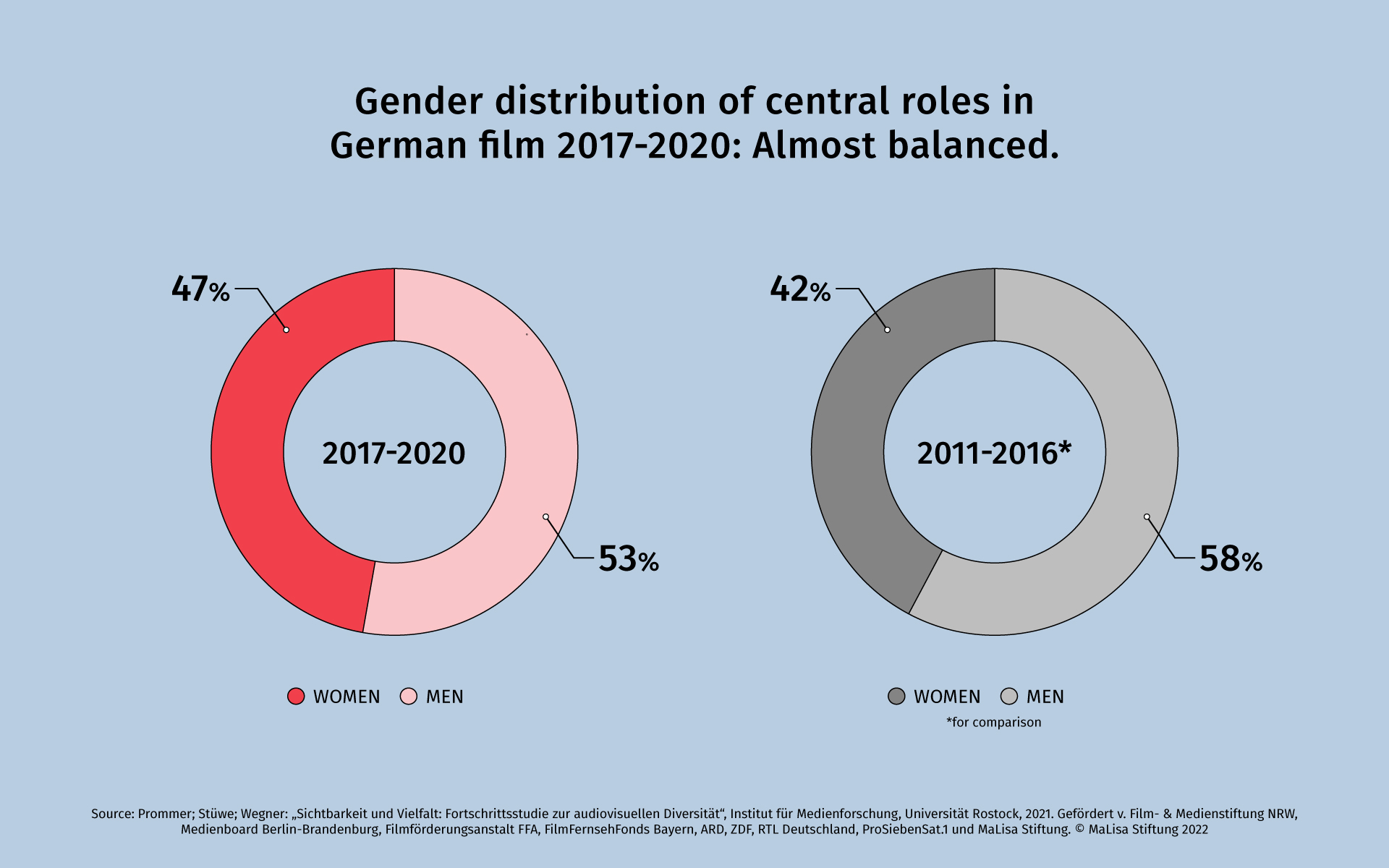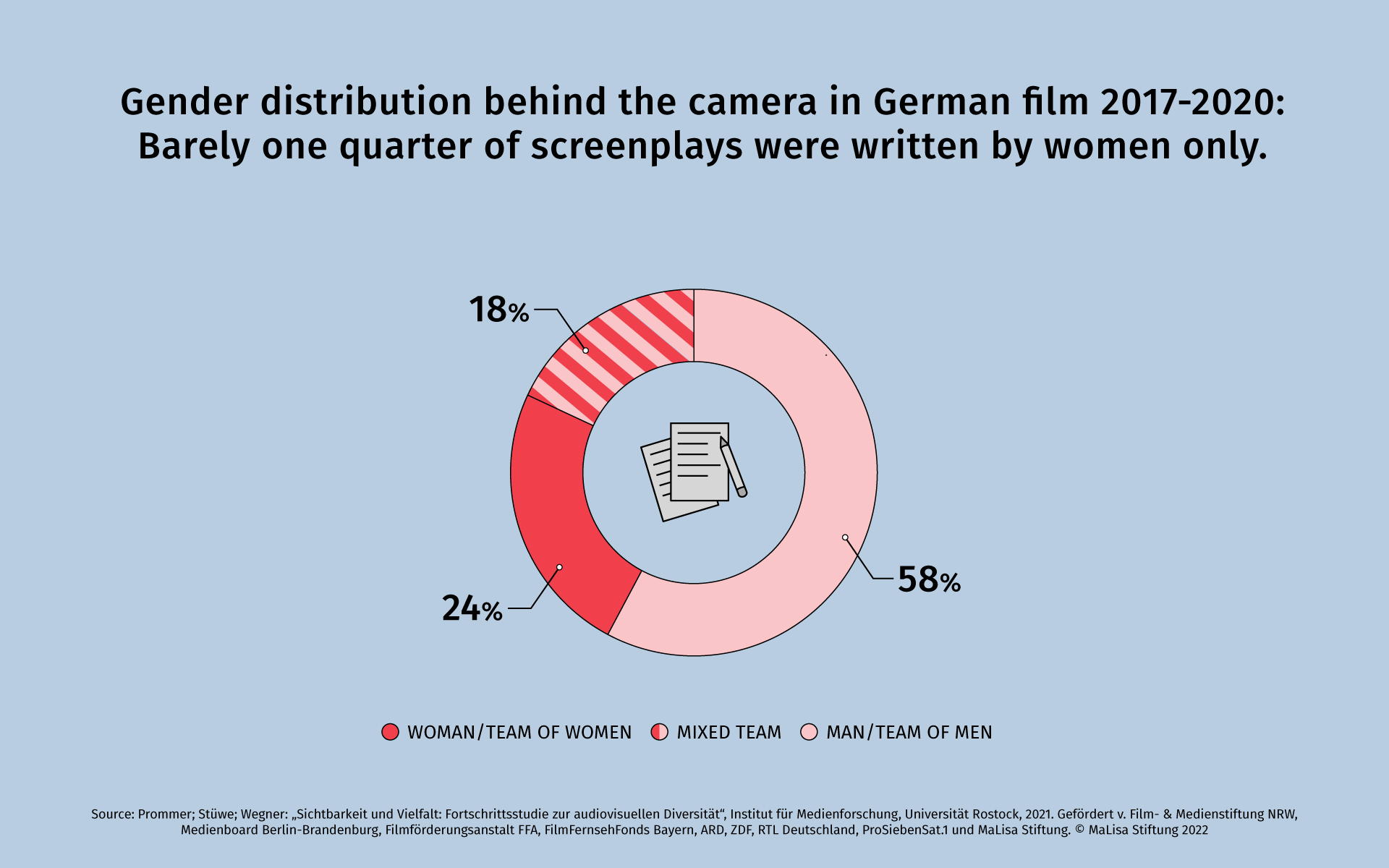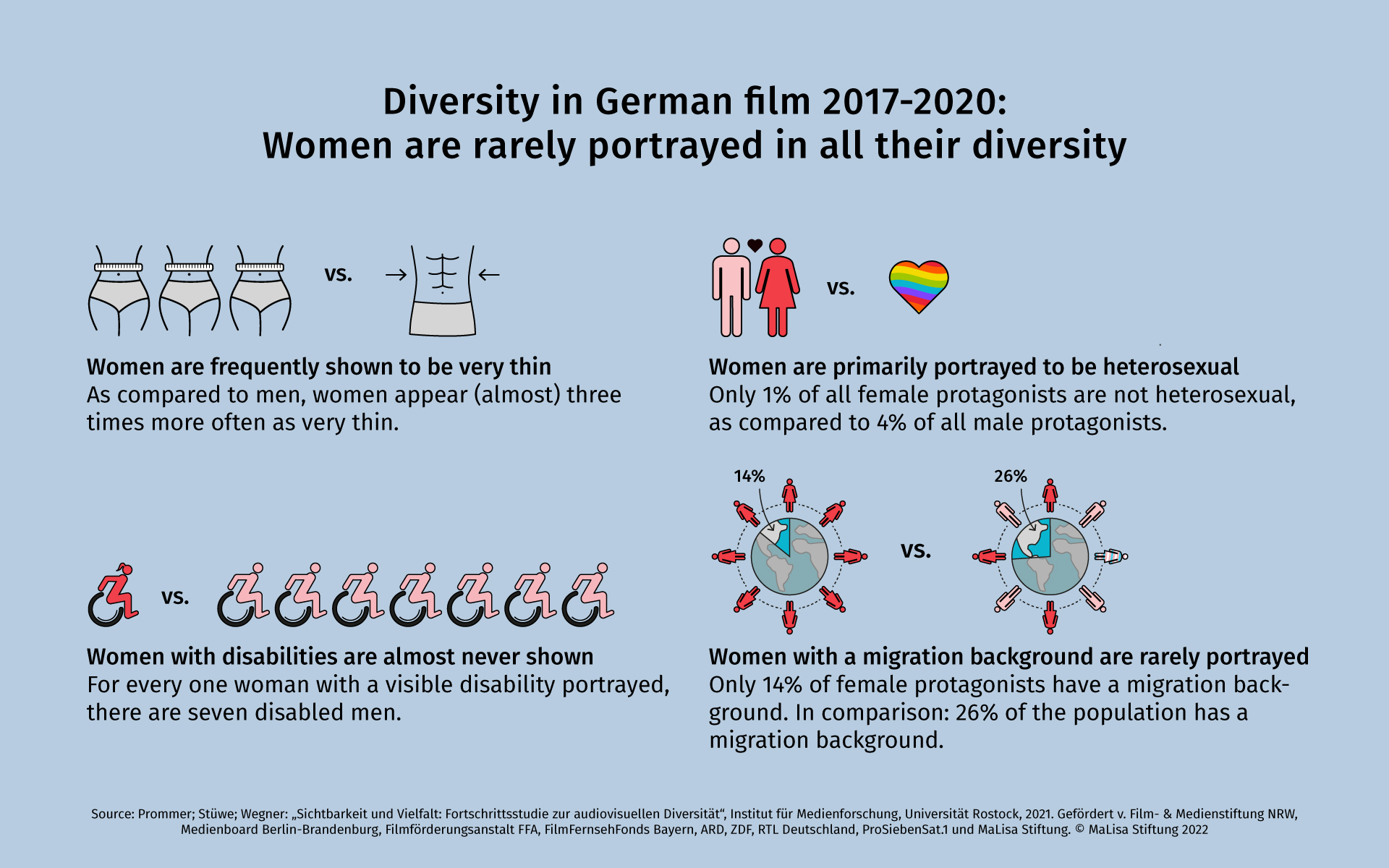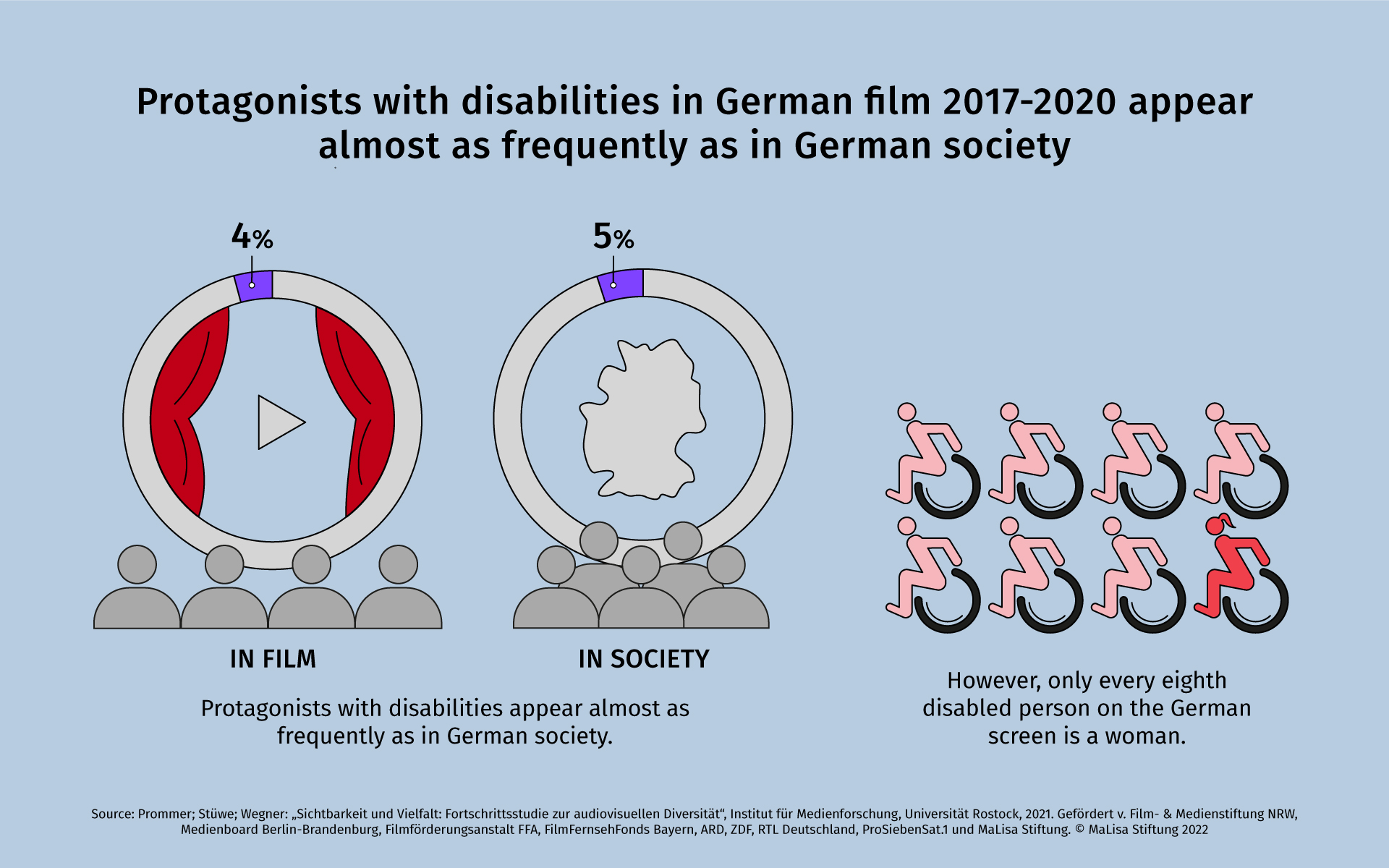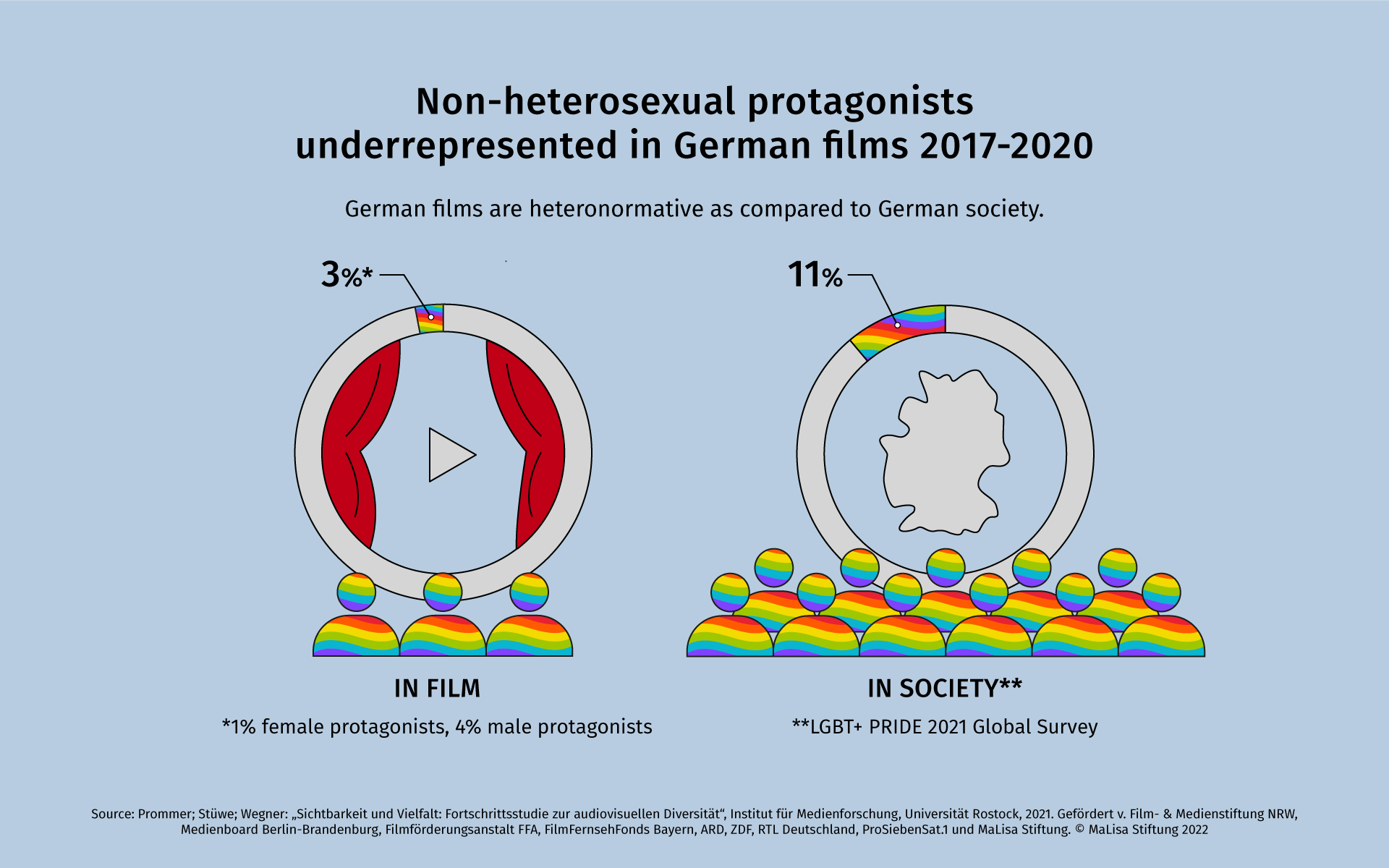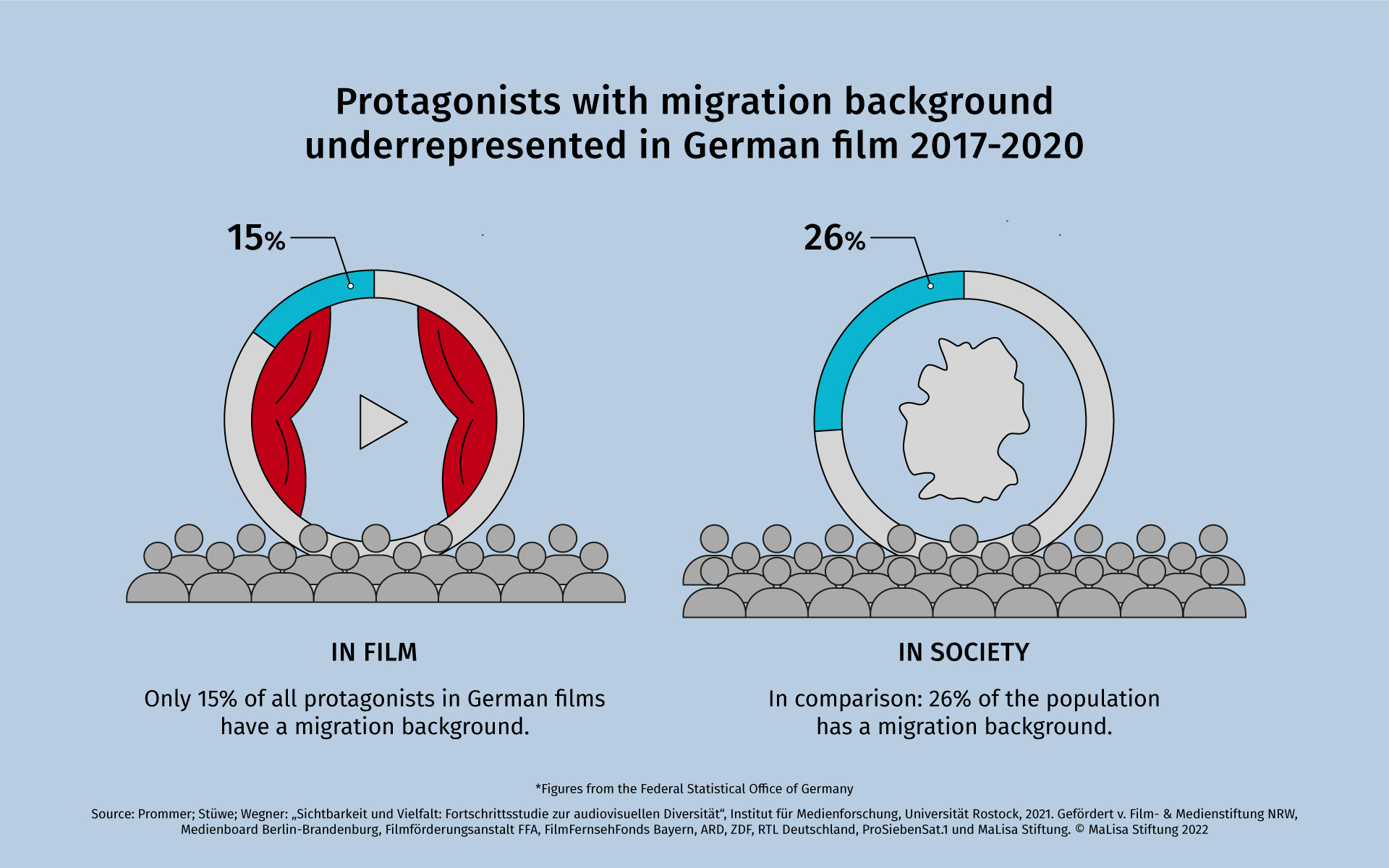PROGRESS STUDY ON AUDIOVISUAL DIVERSITY IN FILM
DIVERSITY IN GERMAN FILM
A new analysis by the University of Rostock probed the question of whether women and men are equally represented in German cinema. The study was launched together with the MaLisa Foundation and its partner institutions. The Progress Study on Audiovisual Diversity, led by Professor Elizabeth Prommer of the Institute for Media Research at the University of Rostock, shows that the proportion of women on screen has increased since 2017. However, women continue to be represented less diversely.
An initial survey in 2017 showed that the number of women and men shown on the big screen was unevenly distributed. The new analysis of gender representation in German cinema films from 2017 to 2020 finds that while women are now visible as protagonists almost as often as men, they continue to appear in less diverse roles.
In addition, the study showed that the number of female characters older than thirty continues to decline, and that more than two-thirds of the central characters over the age of fifty are male. While the total number of female and male protagonists decreases overall with increasing age in German cinema, this trend sets in for women as early as their mid-thirties, but for men as late as age fifty.
The image of women seen in film is consistently severely limited: They are young, thin, and portrayed in the context of partnerships and relationships. Men, on the other hand, have recognizable professions, are occasionally overweight, and are portrayed in a more complex way overall.
German cinema films now show more women in leading roles, but do not depict the diversity of women in reality.
The analysis also shows that women continue to be underrepresented in creative roles behind the camera. For example, they directed a quarter of the feature films between 2017 and 2020 and were responsible for the screenplay in 24 percent of the 390 films studied.
In cases where a woman directed or wrote the screenplay, there were significantly more women visible in the film.
The independent study was conducted by Professor Elizabeth Prommer of the Institute for Media Research at the University of Rostock. It was funded by the Film- und Medienstiftung NRW, the Medienboard Berlin-Brandenburg, the Filmförderungsanstalt FFA, the FilmFernsehFonds Bayern, the public broadcasters ARD and ZDF, the private broadcasters RTL Deutschland and ProSiebenSat.1, and the MaLisa Foundation.
Methodology:
For the analysis, all 390 German feature films released during 2017 and 2020, with 851 protagonists, were examined according to gender, age, sexual orientation, disability, migration background, and "ethnic origin" of the protagonists.
The 100 most successful arthouse and mainstream cinema films were examined in greater depth. For these films, the Bechdel-Wallace test was used to examine the extent to which women are reduced to partnerships and relationships with men.
Non-binary people and people with other gender identities were virtually impossible to identify in the sample. Results are therefore only designated to men and women.
KEY RESULTS
Nearly balanced gender ratio in central roles:
- In 2017-2020, nearly the same number of women (47%) as men (53%) had a central role. This represents an increase of 5%.
Representation of women is still limited:
- There is a persistent age gap: Women in the age group up to their mid-30’s appear equally often, then successively less often. The greatest imbalance is in the 50-plus age group. Here, 70% of the central film roles are played by men.
- Female protagonists, unlike male protagonists, are never overweight and almost three times as often (very) thin.
- The profession of male protagonists is more often recognizable than that of female protagonists, and they more frequently hold a high-level position.
- Women still appear more often in the context of partnerships and relationships.
Women are underrepresented in creative positions:
- 25% of films were directed by women.
- A woman wrote the screenplay for 24% of the films, and a man for 58%. Mixed teams were responsible for 18% of the scripts, thus men were involved in 76% of the scripts.
- The gender of the creative team plays a role in the visibility of female protagonists. The more women are in positions of responsibility, the more women are seen in the film.
- If a woman directs, then the women characters’ stories are more extensive. In this case, 90% of the films pass the Bechdel-Wallace test. The Bechdel-Wallace test examines the extent to which women are reduced to partnerships and relationship with men.
PROGRESS STUDY ON AUDIOVISUAL DIVERSITY IN FILM| MARCH 2022
Additional findings from the progress study on audiovisual diversity in cinema.
Additional results introduce an examination of the dimensions migration background, ethnic attribution, sexual orientation and disability. The findings demonstrate a clear lack of diversity on the screens of German cinemas.
The progress study on audiovisual diversity led by Professor Elizabeth Prommer from the Institute for Media Research at the University of Rostock has been expanded with additional findings. The visibility and representation of the diversity dimensions migration background, ethnic attribution*, sexual orientation and disability in German cinema films from 2017 to 2020 were examined. The results were presented on March 25, 2022 in the opening program of the conference of FILMFEST MÜNCHEN and the Evangelische Akademie Tutzing on the topic Seeing and Being Seen. Representation in Film. The event was publicly accessible as a livestream.
Women are rarely portrayed in all their diversity
The results reveal a clear lack of diversity on the screens of German cinemas. Varied sexual orientations, people with a migration background and people of color are not as visible in terms of diversity on screen as in the population in Germany. It is striking that men are represented more frequently than women in almost all diversity categories. Women, on the other hand, are often portrayed in the context of partnerships and relationships and are shown to be thin, heterosexual and without disabilities.
Protagonists with disabilities appear almost as frequently as in the population
People with disabilities appear in German cinema almost as often as they do in society. However, this applies primarily to male protagonists. Women with disabilities are very rarely portrayed in German films.
Non-heterosexual protagonists are underrepresented
German motion pictures are very heteronormative overall: Only about three percent of the protagonists can be perceived as non-heterosexual. By comparison, according to a representative study by IPSOS in 2021, about eleven percent of Germans classify themselves as non-heterosexual.
Protagonists with a migration background are significantly underrepresented
People with a migration background are clearly underrepresented in German cinema. They represent only 15 percent of all protagonists in German films, compared to over 26 percent in the population. On the definition of „migration background“, please see "Visibility Put to the Test: Progress Study on Audiovisual Diversity: Cinema & Diversity" (in German).
*The comprehensive results of the "Visibility put to the Test: Progress Study on Audiovisual Diversity: Cinema & Diversity". incl. definition of migration background and ethnic origin are available for download here (In German).

PROGRESS STUDY ON AUDIOVISUAL DIVERSITY IN FILM
Diversity in german film
Fotocredit: Joshua Rawson Harris, Unsplash
